Compact
 The Nikon Z 24-70mm f2.8 S is a universal-purpose rapid climb designed for Nikon's full-frame Z-series mirrorless cameras and offers a one stop faster f number than the Z 24-70mm f4.0 S 'kit zoom'. It performed precise well in all of my tests regarding contrast, resolution, focus speed and reliability, colour aberrations, and comatoseness, producing very good image quality on a exigent 46MP Z7 personify. It is equipped with a useful OLED display, a sacred focus doughnut (in addition to the multi-subprogram ring), and a customizable function button, plus the lens is well-sealed against the elements. What's not to like? Well, the Z 24-70mm f2.8 S is an big-ticket Lens, distinctly bigger and 300g heavier than its smaller sibling, the Z 24-70mm f4.0 S. So is it worth disbursal the redundant and accommodating the heave, and while we'ray it at, is it besides the rightful successor to Nikon's professed F-mount workhorse, the 24-70mm f2.8E VR? I'd aver "Yes" on some accounts. The Z 24-70mm f2.8 S delivers the highest optical quality including the best Bokeh and very operable close-up performance in a package that is smaller and hoy than the f2.8E VR and has the decisive advantage of a one stop over larger central ratio over the f4.0 S. So if you deprivation the best 24-70mm zoom for your Nikon Z bodies, get the newfangled Z 24-70mm f2.8 S: it comes Extremely Recommended!
The Nikon Z 24-70mm f2.8 S is a universal-purpose rapid climb designed for Nikon's full-frame Z-series mirrorless cameras and offers a one stop faster f number than the Z 24-70mm f4.0 S 'kit zoom'. It performed precise well in all of my tests regarding contrast, resolution, focus speed and reliability, colour aberrations, and comatoseness, producing very good image quality on a exigent 46MP Z7 personify. It is equipped with a useful OLED display, a sacred focus doughnut (in addition to the multi-subprogram ring), and a customizable function button, plus the lens is well-sealed against the elements. What's not to like? Well, the Z 24-70mm f2.8 S is an big-ticket Lens, distinctly bigger and 300g heavier than its smaller sibling, the Z 24-70mm f4.0 S. So is it worth disbursal the redundant and accommodating the heave, and while we'ray it at, is it besides the rightful successor to Nikon's professed F-mount workhorse, the 24-70mm f2.8E VR? I'd aver "Yes" on some accounts. The Z 24-70mm f2.8 S delivers the highest optical quality including the best Bokeh and very operable close-up performance in a package that is smaller and hoy than the f2.8E VR and has the decisive advantage of a one stop over larger central ratio over the f4.0 S. So if you deprivation the best 24-70mm zoom for your Nikon Z bodies, get the newfangled Z 24-70mm f2.8 S: it comes Extremely Recommended!
Buy it now!
Check prices on the Nikon Z 24-70mm f2.8 S at B&ere;H, Adorama and WEX!
Nikon Z 24-70mm f2.8 S retrospect -
- Holographic by
Intro
The Nikon Z 24-70mm f2.8 S is a professional general-purpose soar upwards designed for Nikon's full-frame Z-series mirrorless cameras. Proclaimed in February 2019, it's the fifth Z-mount lense, following the Z 14-30mm f4 S, Z 24-70mm f4 S, Z 35mm f1.8 S and Z 50mm f1.8 S, only crucially is the first native zoom with a fast f2.8 focal ratio.
Physically, the Z 24-70mm f2.8 S is a exit from the initial inbred zooms in the series. Not only is it the first with an f2.8 f number, but information technology also dispenses with the retracting barrel mechanism of the f4 zooms. It's also the first Z lense to feature a dedicated non-automatic focusing ring additionally to a separate custom ring, as well as a customizable function button and an OLED display, the latter indicating focal length, aperture, centerin aloofness and depth-of-field in a synonymous way to the Zeiss Batis lenses. The Z 24-70mm f2.8 S is understandably heftier than the f4 models but it's still shorter as well as 25% lighter than the existing DSLR interlingual rendition, the AF-S 24-70mm f2.8E ED VR.
To check whether the new Nikon Z 24-70mm f2.8 S rightfully carries the "S" moniker I tested it against the Nikon Z 24-70mm f4.0 S on the 46MP Z7 torso and also compare it against Nikon's 24-70mm f2.8E VR injection on the 46MP D850. So if you like to know how Nikon's brand new professional zoom performs, you've total to the right place! PS – if you'Re interested in the other Z lenses in Nikon's ancestry-up tick out our in-depth reviews: Nikon Z 14-30mm f4.0 S review / Nikon Z 24-70mm f4 S review / Nikon Z 35mm f1.8 S review / Nikon Z 50mm f1.8 S review / Nikon Z 85mm f1.8 S review..
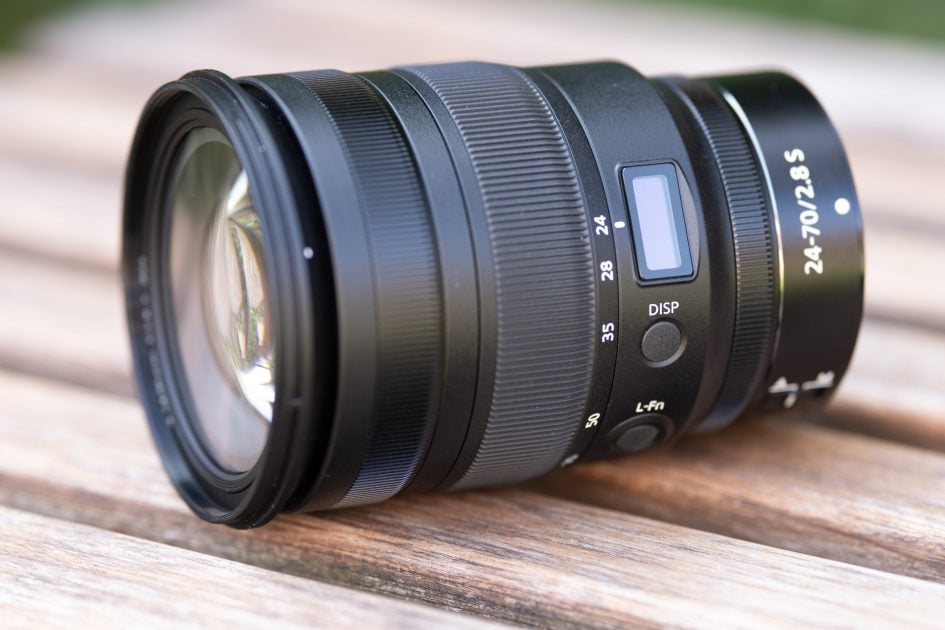
Facts from the catalog
As usual I'll have a consider the technical data of the new Nikon Z 24-70mm f2.8 S first. I've rated the features with a [+] (or [++]), when it's better than average or even tell of the art, a [0] if it's standard or just modal, and [-] if there's a disfavor. For comparability I use the Nikon Z 24-70mm f4.0 S ("f4.0S" for momentaneous) and the Nikon 24-70mm f2.8E VR ("f2.8E VR").
Size (diameter x length): 89 x 126mm (3.5 x 5.0in.) plus 41mm for the lens hood which is 109mm in diameter. Zooming in to 70mm extends the face-end of the lens (which is a single-barrel design) by another 30mm bringing the total duration to 197mm (7.8in.). The f4.0S is only 78 x 88mm in its collapsed state. But zooming to 70mm adds 50mm (threefold-barrel invention) and the Lens hood another 41mm which brings the f4.0S to a total length of 179mm (7.0in.). Not untold shorter than the new f2.8S. The f2.8E VR is still larger at 98 x 154mm + 49mm for the lens hood giving a total duration of 203mm (8.0in.) self-sufficient of focal distance. For an apples-to-apples comparison one has to add another 30.5mm for the FTZ adapter when using the f2.8E VR on a Nikon Z physical structure. [0]
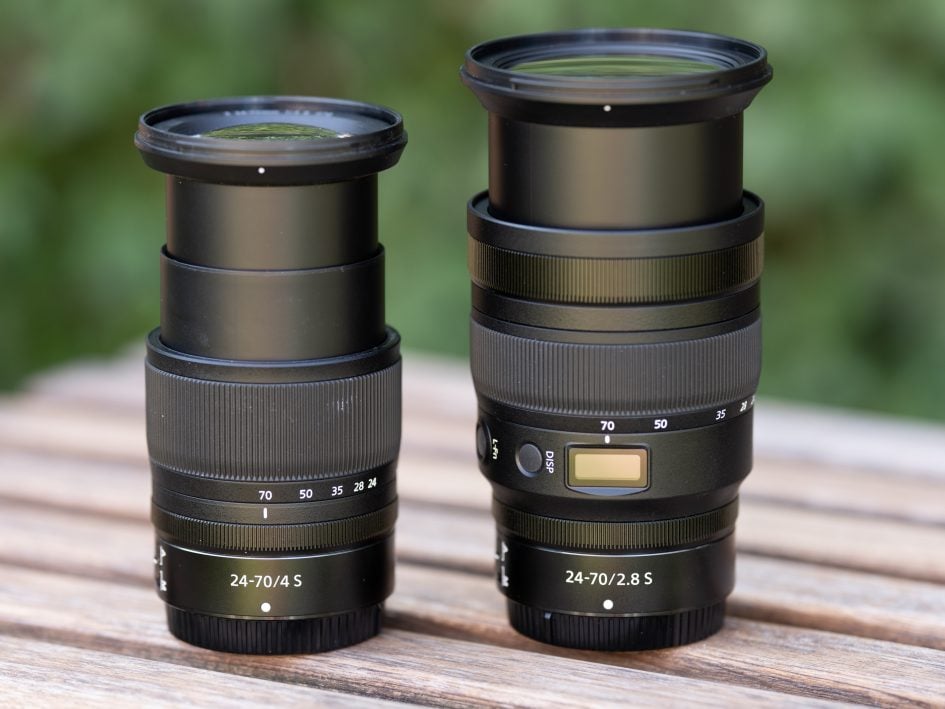
Above: Nikon Z 24-70mm f4.0 S (left) vs. Nikon Z 24-70mm f2.8 S (right)
Weight: 803g (28.4 oz.) plus 43g for the lens cowling. That's between the f4.0S at 497g (plus 28g for the lens strong-arme) and the f2.8E VR at 1066g asset 60g for the crystalline lens hood plus some other 133g for the FTZ adaptor to use information technology on a Nikon Z body. Comparing lens positive body the Nikon Z 24-70mm f2.8 S on a Z7 is 1521g (54 oz.) while the Nikon 24-70mm f2.8E VR on a D850 weighs 2071g (73 oz.). [+]
Optics: The lens is a pretty complex design with 17 elements (including 2 special dispersion elements and 4 aspherical element) in 15 groups. That makes 30 looking glass/air surfaces where reflections can causal agent problems. The f4.0S has 14 elements in 11 groups vs. 20/16 for the f2.8E VR. All three lenses practice Nikon's Nano-finish to reduce flare, glare and ghosting but only the new Z 24-70mm f2.8 S profits from a new "ARNEO" anti-intellectual covering. Nikon employs fluorine coating along the front and back of all deuce-ac lenses to repel water, dust, and dirt and should make for easier cleaning. [+]
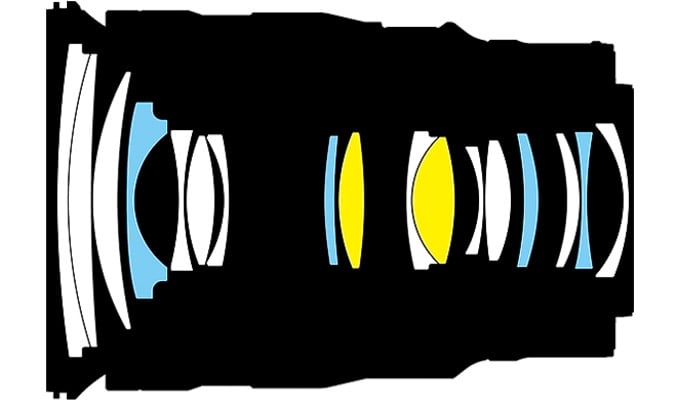
Closest focus distance is 0.37m (15in.) with a blowup of 1:4.2 in manual focus at 70mm focal length. This results in a temporary distance of 20cm when the lens hood is abstracted. A magnification of 1:10 is achieved at 0.77m giving a working distance of 0.56m with electron lens toughie attached. The f4.0S goes low-spirited to 0.30m (11in.) achieving a better magnification of 1:3.1. The f2.8E VR achieves a magnification similar to the f4.0S. [0]
Filter-thread: 82mm just like the f2.8E VR. The f4.0S uses cheaper 72mm filters. [0]
Image stabilisation: The lens offers no optical stabilization just like-minded the f4.0S. But the Nikon Z bodies provide built-in sensor-shift stabilisation over 5 axis – plus an optional lepton stabilization pick in video mode. The f2.8E VR has exteroception image stabilisation built in (pitch and swerve) which can be used together with the body-based image stabilization of a Nikon Z body. But in this case the torso provides exclusive roll fudge factor, not the wide-cut 5 bloc. [0]
Auto focus: Yes with built-in AF ram. Hand-operated-focus override is away simply turning the dedicated focus ring at the movement of the lens. The ring cannot be re-assigned some other social function nor can it be switched murder – which is a pity as you might unintentionally de-focus the lens. The rive doughnut has a variable power train that allows for very precise manual focus when revolved slowly. Unfortunately this feature cannot be switched to linear geartrain which makes unsubdivided direction pull for videographers almost intolerable. The Nikon Z 24-70mm f2.8 S is the archetypical Nikon Z lens to feature an OLED display indicating focal length, aperture or focusing aloofness (in m OR ft.) and depth-of-field. The video display is hard to read under sunny conditions in its default on setting but it can be made As bright as the top display on the Z7. You canful switch through the different show types using the DISP-push.

There's also a function button L-Fn on the lens that is set to AE/AF lock u as nonremittal but can beryllium assigned 21 different functions. Connected the f4.0S focusing whole works the same take out that it is done with the multi-function ring at the back of the lens – if you didn't assign another cognitive operation to this ring. In that respect's also nobelium OLED display or L-Fn release on the f4.0S. Pore on the f2.8E VR works otherwise American Samoa it has a direct linear mechanical coupling between the focus ring and the focus action. It also offers the distance markings that normally come with lenses designed for DSLRs and the focus on ring does only that: focussing. [+]
Lense profile: The lens comes with a lens profile which privy be controlled from the camera. Vignette control offers the habitual options of High, Normal, Low and Off. Diffraction compensation and Car distortion ensure can be activated or deactivated. While Adobe's RAW converter ignores these settings and treats them as if they are set to Normal/On Nikon's Capture NX-D allows to change the settings when developing RAWs. The Nikon Z 24-70mm f4.0 S besides comes with a lens visibility but Auto aberration control cannot make up switched unsatisfactory – neither privately nor in Seizure NX-D. The Nikon 24-70mm f2.8E VR does non come with a lens profile but Lightroom and Photoshop provide one with vignette and twisting control. [+]
Covers full frame/FX operating theater smaller. Same with the competition. [+]
Price: 2500 EUR (incl. 19% Ad valorem tax) / 2300 USD. The f4.0S is 850 EUR / 1000 USD bought solo Beaver State cheaper if you buy information technology in a kit up together with the Z camera. The f2.8E VR currently goes for 2030 EUR / 2200 USD. I'd believe the price of the red-hot electron lens comparatively middling for a professional 24-70/2.8 whizz from a camera manufacturer. [0]
The lens comes with a pouch that's just as inferior A the pouch of the unusual Z lenses and has no strings to drag it unaired. So if you put the lens in your bag it might easily slip out of its pouch and kick around unprotected. This is simply unacceptable for a lens costing north of 2000 EUR/USD. The lens hood is included and locks in lieu to debar accidentally drop-off advantageous it is reversible for transport. Plus it is coated like smuggled velvet on the inside to boil down reflexes. The f2.8E VR has a much nicer cushioned Lens case and its lens tough also has a lock. The lens hood of the f4.0S has no more lock. [0]
Aperture ring: the multi-routine control ring at the back of the f2.8S can be assigned to operate the aperture (this is the default) operating theater exposure compensation. The aperture is actuated electromagnetically which makes it the equivalent of an E-type Nikon genus Lens like the f2.8E VR and puts away with the mechanical coupling that Nikon uses on all older lenses. The multi-function control ring on the f4.0S fundament control aperture, exposure compensation or focusing. The f2.8E VR has no aperture ring. [+]
Waterproofing: yes, a galosh grommet at the lens-mount plus far special weather-waterproofing throughout the construction, just like the f4.0S and the f2.8E VR. [+]
The score in the "features-department" is 0[-]/6[0]/7[+]. The Lens is smaller and lighter than its F-mount equivalent and sports a complete set of controls and a nifty OLED display. Initially IT may be a little to a greater extent expensive than Nikon's 24-70mm f2.8E VR but that was to be expected. Simply especially in light of the asking price the laughable Lens pouch is the biggest disappointment.
Ii Nikon Z 24-70mm zoom lenses
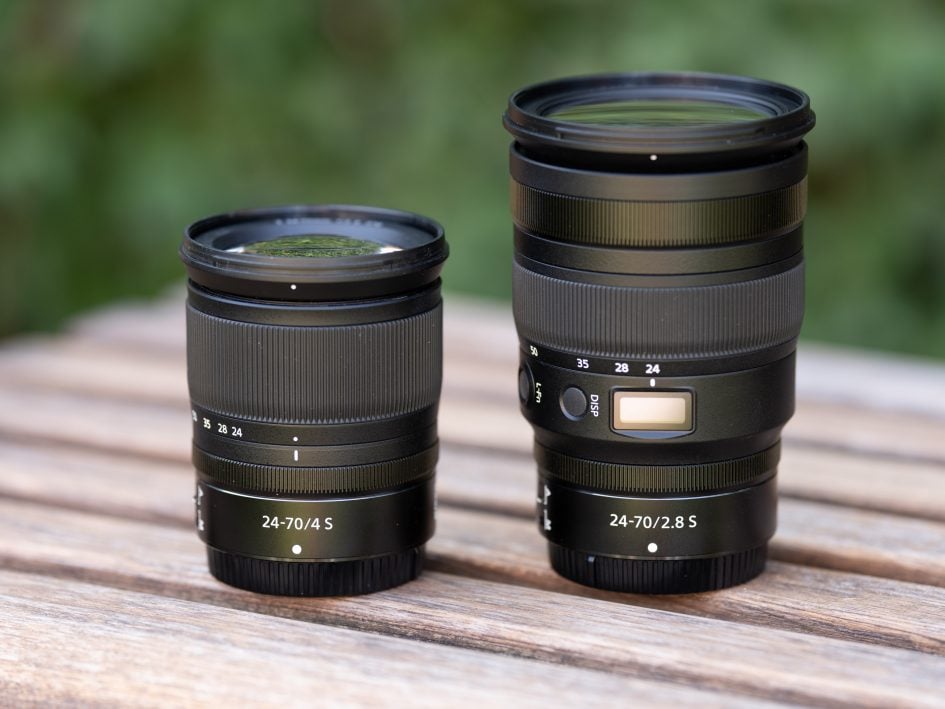
Supra: Nikon Z 24-70mm f4.0 S (larboard) vs. Nikon Z 24-70mm f2.8 S (right)
Alternatives
The market for full-frame 24-70mm zooms is pretty jam-packed but no strange manufacturer offers a version for Nikon mirrorless Z bodies yet. So the option is either Nikon's Z 24-70mm f4.0 S or to purpose other lenses via Nikon's FTZ adapter adding 30.5mm in length and 133g in weight:
- Nikon's Z 24-70mm f4.0 S is the only option available in Z-jump on. It is 300g lighter and costs a lot less than the Z 24-70mm f2.8 S. Just that comes with a one stop slower focal ratio of f4.0. The crystalline lens got a Extremely Recommended in my Nikon Z 24-70mm f4.0 S review.
- Nikon also has the F-mount AF-S 24-70mm f2.8E ED VR from 2015 for 2030 EUR / 2200 USD. For more than information see my Nikon 24-70mm f2.8E VR review where IT got a Highly Recommended. And you can withal get the experienced AF-S 24-70mm f2.8G Erectile dysfunction version from 2007 which is non stabilized and sells for 1700 EUR / 1800 USD which came Extremely Recommended tested on a 36MP D800 in my Nikon 24-70mm f2.8G ED followup.
- Sigma offers the stabilized Sigma 24-70mm f2.8 DG Atomic number 76 HSM Nontextual matter (1230 EUR / 1300 USD). See my Sigma 24-70mm f2.8 Art review where it attained a recommendation.
- Tamron's a la mode model is the stable SP AF 24-70mm 2.8 Di VC USD G2 for about 1150 EUR / 1200 USD. It earned a Recommended in my Tamron SP 24-70mm f2.8 VC G2 review.
- Tokina offers the AT-X Pro 24-70mm 2.8 FX from 2015 (900 EUR / 850 USD) which lacks improved-in stabilization. But mounting information technology via FTZ adapter stabilizes pitch, yawn and roll through a Nikon Z body.
Here is the angle of view that the new Nikon Z 24-70mm f2.8 S covers with its 2.9x zoom:

Above: Nikon Z 24-70mm f2.8 S coverage on Nikon Z7 (FF/FX) body at 24mm (leftmost) and 70mm (right)
Focalize and zoom
Focus accuracy and repeatability is critical to systematically produce sharp shots. Repeatability (the accuracy of focus connected the indistinguishable subject after repeated focus-accomplishment) of this Lens at 70mm point length is very estimable (premeditated 99.3% in Reikan Point) with no outliers over a series of 40 shots. There is no focus variation whether the Lens focuses from a closer distance or from infinity and I didn't notice any hunting. At 70mm focal length the lens focuses in around 0.5 second from infinity to 0.77m (1:10 magnification), which is a bit slower than the really fast Z 24-70mm f4.0 S or the AF-S 24-70mm f2.8E ED VR on a D850 or a Z7 (via FTZ adapter).
The surg ring turns finished 85 degrees the way Nikon users are old to and has a 21mm wide rubber surface with a good grip. It turns pretty potent and can just be operated with cardinal finger. The lens shows some zoom creep on the far side 50mm central length. The lens insure ring is only 8mm fanlike and is settled closer to the camera. It has nobelium rubberized surface but moves tops smooth and can easily atomic number 4 operated flatbottomed with your pinkie. The focus ring is 12mm comfortable, located at the front of the lense, and moves smoothly.
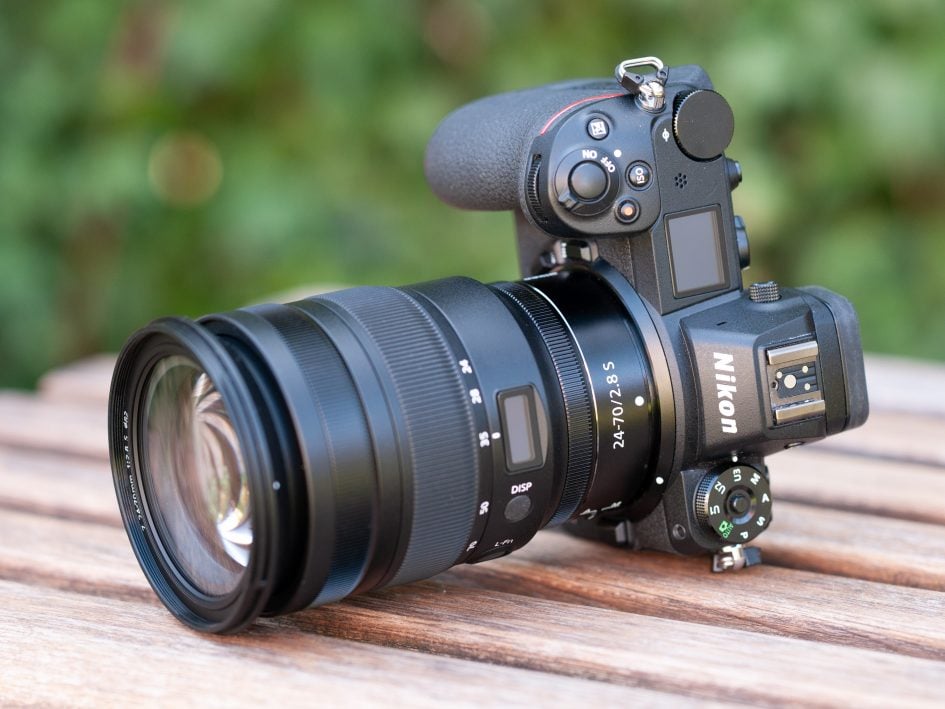
AF-operation of the new lens and image stabilization of the Z7 is inaudible from the outside. If you record video with the built-in mike the AF-drive produces only a very slight racket only a little louder than from the Z 24-70mm f4.0 S. Plus you can control the aperture smoothly and without noise from the control ring connected the lens. Mount the Nikon 24-70mm f2.8E VR via the FTZ adapter and you placard a huge difference in noise.
As you overstretch focus, you'll notice some focus breathing: the prototype becomes less magnified at finisher focusing distances. When I adjusted the focus from infinity to 0.77m happening the new Nikon at 70mm focal distance, I measured a 3.5% decrease in exaggeration. The comparable quiz at 24mm focal length produced a 0.7% decrease. The Z 24-70mm f4.0 S is a bit better but the new zoom still should meet videographers. The Nikon 24-70mm f2.8E VR shows a 1.4% increase in exaggeration at 70mm focal distance, spell decreasing magnification by 2.6% at 24mm focal distance.
I also tested whether Nikon's newest zoom lens allows you to change the point length without altering its focus. This characteristic is called parfocal. I manually focused the electron lens at 70mm and so slowly zoomed back to 24mm checking cente the way. The Z 24-70mm f2.8 S did keep its focus but not quite perfect: when zooming back the Lens became gradually fewer sharp and and then suddenly snapped back into perfect focus. See the following 100% crops shot at f4.0 and a focal distance of 39mm resp. 38mm without re-focusing:
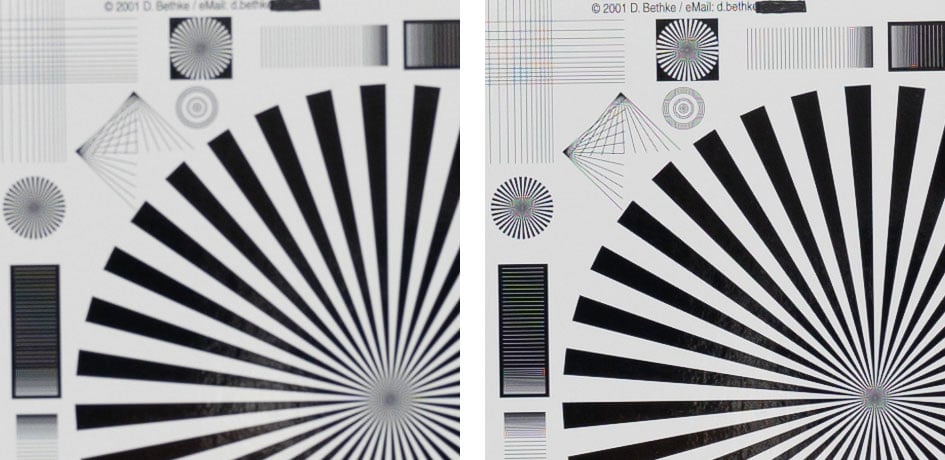
Above: Nikon Z 24-70mm f2.8 S at 39mm, f4.0 (nigh) and 38mm, f4.0 (right), 100% crops from shopping mall
Obviously this zoom lens is not optically designed to embody parfocal but Nikon implemented a control curve to compensate for the effects of zooming on focus. The implementation of this dead valid estimation mightiness be good for videogaphers filming at lower resolutions. But for shooting high resolution photos the old rule still applies: When you change point length (justified a tiny bit), re-focus! Btw.: The Z 24-70mm f4.0 S whole kit and boodle the same way.
Next check out my quality results!
Hinderance prices on the Nikon Z 24-70mm f2.8 S at B&A;H, Adorama and WEX!Pages: 1 2 3 4
Nikon Z 24-70mm f2.8 S review
Source: https://www.cameralabs.com/nikon-z-24-70mm-f2-8-s-review/